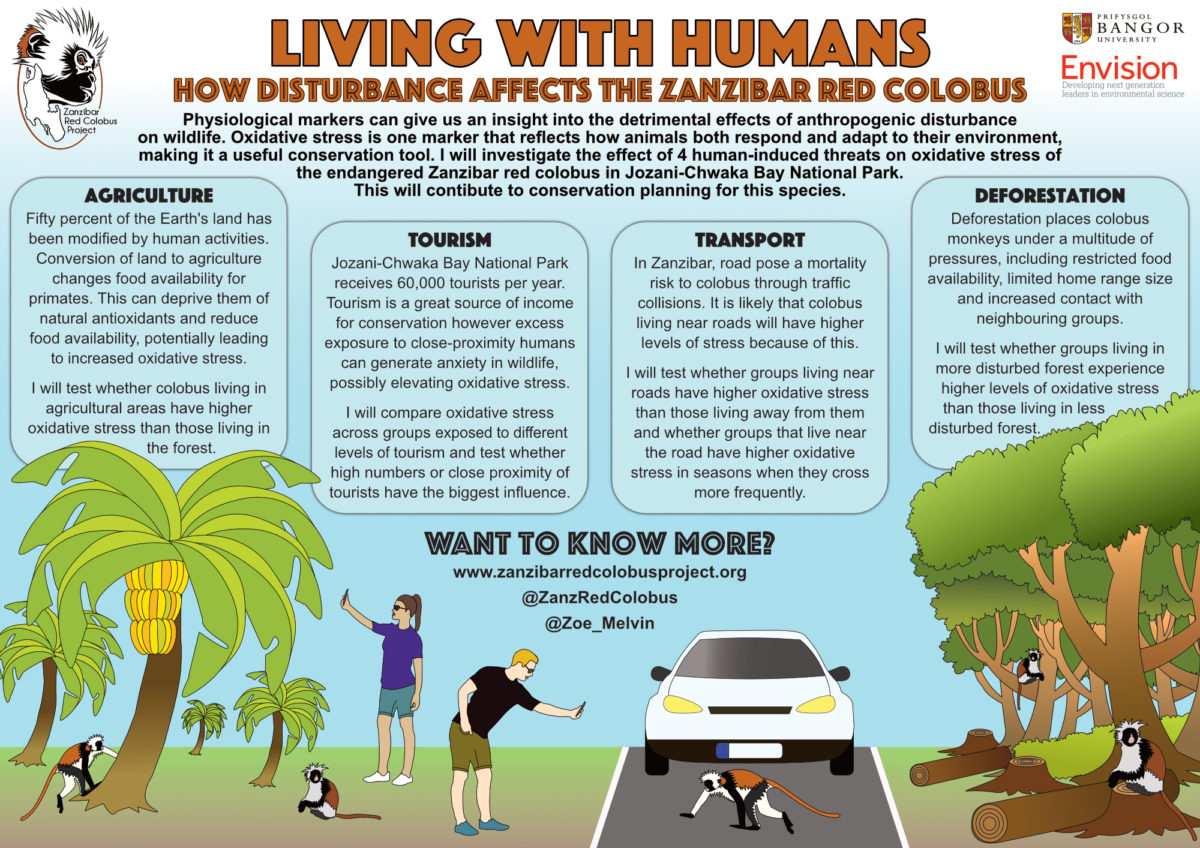Summary
This infographic aims to explain the rationale and plan for my PhD research to undergraduate and postgraduate students. I hope that it communicates my research in a simple and visually-appealing way to increase engagement with students within and outside of my institution. It advertises my research and my research group to prospective students.
Transcript
Physiological markers can give us an insight into the detrimental effects of anthropogenic disturbance on wildlife. Oxidative stress is one marker that reflects how animals both respond and adapt to their environment, making it a useful conservation tool. I will investigate the effect of 4 human-induced threats on oxidative stress of the endangered Zanzibar red colobus in Jozani-Chwaka Bay National Park.
Agriculture
Fifty percent of the Earth’s land has been modified by human activities. Conversion of land to agriculture changes food availability for primates. This can deprive them of natural antioxidants and place them under nutritional stress potentially leading to increased oxidative stress. I will test whether colobus living in agricultural areas have higher oxidative stress than those living in the forest.
Tourism
Jozani-Chwaka Bay National Park receives 60,000 tourists per year. Tourism is a great source of income for conservation however excess exposure to close-proximity humans can generate anxiety in wildlife, possibly elevating oxidative stress. I will compare oxidative stress across groups exposed to different levels of tourism and whether high numbers or close proximity of tourists have the biggest influence.
Transport
Transport, particularly roads, pose a mortality risk to colobus through car collisions. It is likely that colobus living near roads will experience higher levels of stress. I will test whether groups living near roads have higher oxidative stress than those living far away from them and whether groups that live near the road have higher oxidative stress in seasons when they cross more frequently.
Deforestation
Deforestation places colobus monkeys under a multitude of pressures, including restricted food availability, limited home range size and increased contact with neighbouring groups. I will test whether groups living in more disturbed forest experience higher levels of oxidative stress than those living in less disturbed forest.
Expected outcomes
Elevated oxidative stress indicates reduced health, longevity and reproductive success and therefore could potentially indicate future population dynamics. The results from this study will contribute to a conservation plan for the species and will demonstrate the potential use of oxidative stress as a conservation tool in other species.
Find out more about the Zanzibar Red Colobus Project
Zoe Melvin

Zoe is a PhD student at Bangor University where she studies the effects of human disturbance on the physiology and reproduction of the endemic and endangered Zanzibar red colobus monkey. She hopes that this information will be useful in creating conservation plans for the species. She has conducted behavioural research on primates in South Africa, Nigeria, Mozambique and Tanzania and is interested in answering questions to provide practical solutions to conservation.
Zoe’s Bangor University profile
Email: zoe.melvin@bangor.ac.uk
Twitter: @Zoe_Melvin
Organisation: Bangor University

